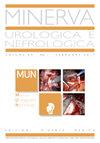肾评分在预测机器人肾部分切除术后并发症中的作用。
Q1 Medicine
引用次数: 3
摘要
本研究的目的是评估基于肾肾测量评分的肿瘤复杂性与并发症之间的关系。方法回顾性分析2555例肾细胞癌行RPN治疗的患者。主要并发症定义为clavien分级≥3级。采用卡方独立性检验、fisher精确检验和Kruskal Wallis检验评估基线人口学、临床特征、围手术期和术后结局与肿瘤复杂性的关系。采用未调整和调整的logistic回归模型评估主要并发症与人口统计学、临床特征和围手术期结局的关系。结果肿瘤复杂性与WIT(p<0.001)、手术时间(p<0.001)、估计失血量(p<0.001)、主要并发症(p=0.019)有显著相关。但与总并发症(p=0.237)和住院时间(LOS) (p=0.085)无关。在未调整的模型中,较高的肿瘤复杂性与主要并发症相关(p=0.009)。在控制其他变量的情况下,主要并发症和肿瘤复杂性的差异无统计学意义(低vs中等,p=0.142,高,p=0.204)。在调整后的模型中,LOS (p <0.001)和手术时间(p=0.025)仍然是主要并发症的重要预测因素。结论肿瘤复杂性与RPN术后总并发症或主要并发症发生率的增加无关。高容量中心的经验表明,RPN术后并发症发生率的标准化与肿瘤复杂性无关。本文章由计算机程序翻译,如有差异,请以英文原文为准。
The role of RENAL score in predicting complications after robotic partial nephrectomy.
BACKGROUND
The aim of this study is to evaluate the association between tumor complexity based on RENAL nephrometry score and complications.
METHODS
We retrospectively identified 2555 patients who underwent RPN for renal cell carcinoma. Major complication was defined as clavien grade≥3. The relationship between baseline demographic, clinical characteristics, perioperative and postoperative outcomes, and tumor complexity were assessed using Chi-square test of independence, Fishers exact and Kruskal Wallis test. An unadjusted and adjusted logistic regression model was used to assess the relationship between major complication and demographic, clinical characteristics, and perioperative outcomes.
RESULTS
There was a significant relationship between tumor complexity and WIT(p<0.001), operative time(p<0.001), estimated blood loss (p<0.001), and major complication(p=0.019). However, there was no relationship with overall complications(p=0.237) and length of stay (LOS) (p=0.085). In the unadjusted model, higher tumor complexity was associated with major complication (p=0.009). Controlling for other variables, there was no significant difference between major complication and tumor complexity (low vs. moderate, p=0.142 and high, p=0.204). LOS (p <0.001) and operative time (p=0.025) remained a significant predictor of major complication in the adjusted model.
CONCLUSIONS
Tumor complexity is not associated with an increase in overall or major complication rate after RPN. Experience in high-volume centers is demonstrating a standardization of low complications rates after RPN independent of tumor complexity.
求助全文
通过发布文献求助,成功后即可免费获取论文全文。
去求助
来源期刊

Minerva Urologica E Nefrologica
UROLOGY & NEPHROLOGY-
CiteScore
5.50
自引率
0.00%
发文量
0
审稿时长
>12 weeks
期刊介绍:
The journal Minerva Urologica e Nefrologica publishes scientific papers on nephrology and urology. Manuscripts may be submitted in the form of Minerva opinion editorials, editorial comments, original articles, video illustrated articles, review articles and letters to the Editor.
 求助内容:
求助内容: 应助结果提醒方式:
应助结果提醒方式:


